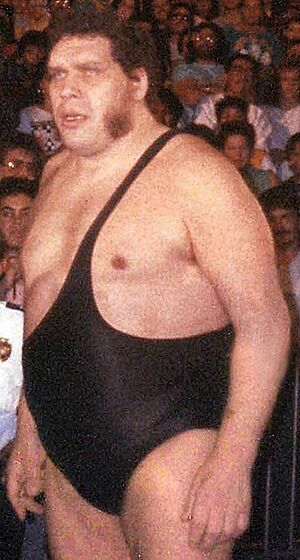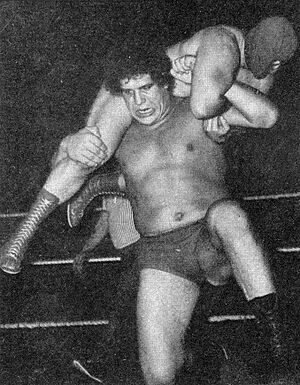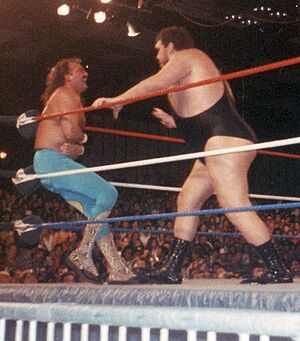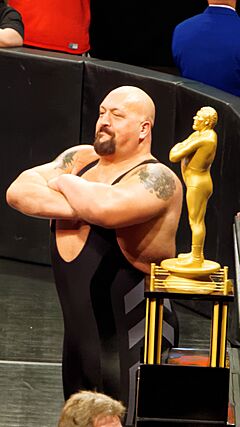André the Giant facts for kids
Quick facts for kids André the Giant |
|
|---|---|

André in 1989
|
|
| Birth name | André René Roussimoff |
| Born | 19 May 1946 Coulommiers, France |
| Died | 28 January 1993 (aged 46) Paris, France |
| Children | 1 |
| Professional wrestling career | |
| Ring name(s) | André Roussimoff André the Giant André the Giant Frenchman The Ultimate Giant Géant Ferré Giant Machine Jean Ferré Monster Eiffel Tower Monster Roussimoff The Polish Giant |
| Billed height | 7 ft 4 in (224 cm) |
| Billed weight | 520 lb (236 kg) |
| Billed from | "Grenoble in the French Alps" |
| Trained by | Michel Saulnier |
| Debut | 25 January 1966 |
André René Roussimoff (born May 19, 1946 – died January 28, 1993) was a famous French professional wrestler and actor. He was best known by his wrestling name, André the Giant. People called him "the Eighth Wonder of the World" because of his huge size. This size was due to a condition called gigantism, which means his body made too much growth hormone.
André started his wrestling career in 1966. In 1971, he moved to North America. From 1973 to the mid-1980s, he was a special attraction for the World Wide Wrestling Federation (WWWF). He wrestled all over the United States and in Japan. During the big wrestling boom of the 1980s, André became a huge star in the WWWF (which was later called the World Wrestling Federation). He teamed up with the manager Bobby Heenan and had a famous rivalry with Hulk Hogan. They had a huge match at WrestleMania III in 1987. In 1988, André beat Hogan to win the WWF Championship. This was his only world heavyweight championship. After 1990, André wrestled mostly in Japan until he passed away suddenly.
After his death in 1993, André Roussimoff was the very first person to be put into the new WWF Hall of Fame. He is remembered as one of the most famous people in the world, both in wrestling and pop culture. Outside of wrestling, André is well-known for playing Fezzik, the giant, in the 1987 movie The Princess Bride.
Contents
Early Life
André René Roussimoff was born on May 19, 1946, in Coulommiers, Seine-et-Marne, France. His parents were immigrants; his father was from Bulgaria and his mother was from Poland. He had two older siblings and two younger ones. As a child, his nickname was Dédé.
When André was born, he weighed about 13 pounds (6 kg). As he grew, he showed signs of gigantism. He was always much taller than other kids and had very long hands. His mother was about 5 feet 2 inches tall, and his father was 6 feet 2 inches tall. By the time André was 12, he was already 6 feet 3 inches tall.
André was an average student. He was good at math. When he was 14, he decided to stop school and start working. He believed he had learned enough to work on a farm. He worked on his father's farm, where he could do the work of three men. He also learned woodworking and worked in a factory.
Interestingly, when André was growing up, the famous writer Samuel Beckett sometimes drove local children to school. André and Beckett became friends. They often talked about their shared love for cricket.
Professional Wrestling Career
Starting Out (1964–1971)
When André was 18, he moved to Paris. A wrestling promoter named Robert Lageat saw how big André was and decided to train him. André trained at night and worked as a mover during the day. He started wrestling in Paris under the name "Géant Ferré." This name came from a French folk hero.
In 1966, Canadian promoter Frank Valois met André. Valois later became André's business manager. André started wrestling in many countries, including the United Kingdom, Germany, Australia, New Zealand, and Africa.
He first wrestled in Japan in 1970, where he was called "Monster Roussimoff." He quickly became a tag team champion there. While in Japan, doctors told André that he had acromegaly. This is a condition where the body produces too much growth hormone.
In 1971, André moved to Montreal, Canada. He was very popular and often sold out the Montreal Forum. However, soon there were not enough good opponents for him. People became less excited about his size, and fewer tickets were sold.
Traveling Star (1971–1984)
In 1973, Vincent J. McMahon, who started the World Wide Wrestling Federation (WWWF), had ideas to make André even more famous. He wanted André to be seen as a huge, unbeatable monster. To make him seem even bigger, McMahon told André not to do agile moves like dropkicks. André was also given the new name "André the Giant." McMahon also made sure André wrestled all over the world. This way, people wouldn't see him too often in one place. Promoters had to pay André a lot of money and also pay McMahon's company.
On March 24, 1973, André debuted in the WWWF (which later became the World Wrestling Federation). He was a fan favorite, meaning people cheered for him. He won his first match in Philadelphia. Two days later, he wrestled in New York's famous Madison Square Garden.
André was one of the most loved wrestlers in the 1970s and early 1980s. It was often said that he had not been defeated by pinfall or submission in 15 years in the WWF. However, he did lose some matches outside of the WWF.
In 1976, André had a special match against boxer Chuck Wepner. This fight was part of a big event. André won by throwing Wepner out of the ring.
In 1980, André had a rivalry with Hulk Hogan. At this time, Hogan was the bad guy, and André was the hero. They wrestled at Shea Stadium, where André pinned Hogan. After the match, Hogan lifted André and slammed him to the mat. This was similar to their famous match years later.
André also had a big rivalry with "Mongolian Giant" Killer Khan. In their storyline, Khan hurt André's ankle during a match in 1981. In real life, André had broken his ankle getting out of bed. This injury was then used in their wrestling story. André returned for revenge. They had many intense matches, including a "Mongolian stretcher match." In this match, the loser had to be carried out on a stretcher. André won this match.
World Wrestling Federation (1984–1991)
Teaming with Bobby Heenan and Ted DiBiase (1987–1989)

In early 1987, André agreed to become a "heel." This means he would play the bad guy to go against Hulk Hogan, who was the biggest hero in wrestling. On a TV show called Piper's Pit, Hogan received a trophy for being champion for three years. André came out to congratulate him.
The next week, André received a trophy for being "the only undefeated wrestler in wrestling history" in the WWF. Hogan came out, but André walked away during Hogan's speech. Later, André appeared with his new manager, Bobby Heenan. Heenan accused Hogan of only being André's friend to avoid wrestling him for the title. André then ripped off Hogan's shirt and necklace, scratching Hogan's chest. This led to a challenge for the WWF World Heavyweight Championship at WrestleMania III.
Before WrestleMania III, André threw Hogan out of the ring in a battle royal. This made it seem like André had a big advantage.
At WrestleMania III, André was said to weigh 520 pounds (236 kg). His huge weight caused him constant pain. He was also wearing a back brace under his wrestling outfit. In front of a record crowd, Hogan won the match. He lifted André and slammed him to the mat. This move was later called "the bodyslam heard around the world." Hogan later said André felt much heavier than 520 pounds.
It was not the first time Hogan had slammed André in a WWF match. He had done it in 1980. However, most fans watching WrestleMania III had never seen André slammed before.
The rivalry between André and Hogan continued. At the first Survivor Series event, they were captains of opposing teams. André was the sole survivor of the match. Later, André attacked Hogan from behind and choked him. It took many other wrestlers to pull André away.
Meanwhile, Ted DiBiase, "the Million Dollar Man," wanted to buy the WWF World Heavyweight Championship from Hogan. When Hogan refused, DiBiase turned to André to win it for him. André and DiBiase had teamed up before, but this was not mentioned. This led to a rematch between Hogan and André on The Main Event in 1988. André won the WWF World Heavyweight Championship from Hogan. However, it was later revealed that the referee was a fake. The real referee was held backstage. The fake referee counted Hogan's shoulders down even though they were off the mat.
After winning, André "sold" the title to DiBiase. But the WWF president, Jack Tunney, said this was not allowed. The title was then made vacant, meaning no one held it. At WrestleMania IV, André and Hogan wrestled again. The match ended in a double disqualification. Their rivalry ended after a steel cage match in July 1988, which Hogan won.
At the first SummerSlam event, André and DiBiase (called The Mega Bucks) faced Hogan and Randy Savage (called The Mega Powers). Hogan and Savage won the match.
André also had a rivalry with Jim Duggan. This started when Duggan hit André with a wooden board. André usually got the better of Duggan in their matches.
André's next big rivalry was with Jake "The Snake" Roberts. In this story, André was said to be afraid of snakes. Roberts used his snake, Damien, to scare André. André would often run from the ring when Roberts brought his snake. This rivalry ended at WrestleMania V.
In 1989, André had a short rivalry with Big John Studd. Studd was now a hero, and André was still the bad guy.
Later in 1989, André had a brief rivalry with The Ultimate Warrior. André started wearing face paint like The Warrior and called himself "The Ultimate Giant." The younger Warrior often quickly defeated André. This was done to show The Warrior as the next big star.
The Colossal Connection (1989–1990)
In late 1989, André teamed up with Haku. They formed a new tag team called the Colossal Connection. This helped keep André in the main events as he got older. They quickly won the WWF Tag Team Championship from Demolition.
André and Haku defended their titles until WrestleMania VI in 1990. Demolition won the belts back. After the match, their manager, Bobby Heenan, blamed André for the loss and slapped him. André slapped Heenan back, sending him out of the ring. André also pushed Haku away. This made André a hero again for the first time since 1987. Because of his health, André could not wrestle much at this time. Haku wrestled most of the match against Demolition by himself.
After WrestleMania VI, André wrestled one more time with Haku. Then, André and Haku fought each other, ending their team. André's last WWF match of 1990 was in Japan. He teamed with Giant Baba to defeat Demolition.
Occasional Appearances (1990–1991)
André returned to the WWF in 1991. He appeared on TV to support Big Boss Man. At WrestleMania VII, he helped Boss Man in his match. André finally wrestled again in April 1991. He teamed with The Rockers in a winning match. His last WWF match was a battle royal in May 1991.
André's last big WWF storyline involved different managers trying to get him to join them. He turned them all down. Finally, Jimmy Hart said he had signed André to team with Earthquake. André denied this. Earthquake then attacked André, hurting his knee. This led to André's final major WWF appearance at SummerSlam 1991. He was on crutches at ringside. After a match, Earthquake and Typhoon tried to attack André, but other wrestlers stopped them. André hit both Earthquake and Typhoon with his crutch as they left. His very last WWF appearance was in Paris, France, in October 1991. He was at ringside to support Davey Boy Smith.
All Japan Pro Wrestling; Universal Wrestling Association (1990–1992)
After WrestleMania VI, André spent the rest of his wrestling career in Japan and Mexico. He wrestled in All Japan Pro Wrestling (AJPW) three times a year, usually teaming with Giant Baba. In Mexico, he wrestled as "André el Gigante."
André made a few guest appearances for the Universal Wrestling Federation in 1991. He also appeared on World Championship Wrestling's (WCW) Clash of the Champions XX in 1992, where he gave a short interview.
He had his final wrestling tour in Japan from October to December 1992. He wrestled his very last match on December 4, 1992. He teamed with Giant Baba and Rusher Kimura to win a tag team match.
Acting Career
André started acting in the 1970s and 1980s. His first acting role in the USA was playing a Sasquatch (Bigfoot) in a TV show called The Six Million Dollar Man in 1976. He also appeared in other TV shows like B. J. and the Bear and The Fall Guy.
Towards the end of his career, André was in several movies. He had a small role as Dagoth in the 1984 film Conan the Destroyer. He also appeared in Micki & Maude that same year. His most famous role was Fezzik in the 1987 film The Princess Bride. André loved this role. He enjoyed that no one stared at him on set because everyone was used to his size. He would often make his wrestling friends watch the movie with him and ask, "Did you like my performance?"
His last movie was a small role as a circus giant in the comedy Trading Mom, which came out in 1994, after he had passed away.
Filmography
| Year | Title | Role | Notes |
|---|---|---|---|
| 1967 | Casse-tête chinois pour le judoka | Fighter | Film |
| 1976 | The Six Million Dollar Man | Sasquatch | Television (episodes: "The Secret of Bigfoot, Part 1" and "The Secret of Bigfoot Part 2") |
| 1978 | Symphorien | Television | |
| 1981 | B. J. and the Bear | Manny Felcher | Television (episode: "Snow White and the Seven Lady Truckers, Part 1") |
| 1982 | The Fall Guy | Killer Typhoon (uncredited) | Television (episode: "Ladies on the Ropes") |
| Les Brillant | Jean Petit | Television | |
| 1983 | The Greatest American Hero | Monster | Television (episode: "Heaven Is in Your Genes") |
| 1984 | Conan the Destroyer | Dagoth (uncredited) | Film |
| Micki & Maude | Himself | Film | |
| 1985 | I Like to Hurt People | Himself | Film |
| The Goonies 'R' Good Enough | Himself (uncredited) | Music video | |
| 1987 | The Princess Bride | Fezzik | Film |
| 1994 | Trading Mom | Circus Giant | Film, released after his death |
Personal Life
In the 1974 Guinness Book of World Records, André was listed as the highest-paid wrestler ever. He earned about $400,000 a year at that time.
André had one child, a daughter named Robin Christensen. Robin had regular contact with her father, but she only saw him five times in her life. After he passed away, Robin spoke kindly about her father. She now helps protect his image and legacy.
The writer William Goldman, who wrote The Princess Bride, said André was one of the kindest and most generous people he knew. André always insisted on paying when he ate with others. Once, he even lifted Arnold Schwarzenegger onto a car when Schwarzenegger tried to pay the bill first!
André owned a ranch in Ellerbe, North Carolina. He loved spending time there when he wasn't traveling. He took care of his cattle, played with his dogs, and had friends over. While he had some custom-made furniture, stories that everything in his home was custom-made are not entirely true. Because it was hard for him to go shopping due to his fame and size, he often bought things from the shopping channel QVC.
Health
André had a serious heart condition called pericardial effusion. He had surgery for it in the 1980s.
Death
André Roussimoff passed away at age 46 in his sleep. He died from congestive heart failure and a heart attack. This was likely related to his untreated acromegaly. He was in Paris to attend his father's funeral and decided to stay longer for his mother's birthday.
In his will, André wanted his body to be cremated. After his death, his family in France held a funeral. But when they learned of his wish, his body was flown to the United States. He was cremated, and his ashes were scattered at his ranch in Ellerbe, North Carolina. He left his property to his daughter, Robin.
Other Media
André Roussimoff has appeared as himself in many video games. His first appearance was in WWF WrestleMania. He also appears in games like WWE 2K14 and many others after his death.
In 2005, WWE released a DVD called André The Giant. It was about his life and wrestling career.
Legacy
- In 1993, the World Wrestling Federation created the WWE Hall of Fame. André the Giant was the very first person to be inducted.
- André was the inspiration for the 1998 movie My Giant. It was written by his friend Billy Crystal, whom he met while filming The Princess Bride.
- Wrestler Paul Wight, known as Big Show, is often compared to André because of his large size. Big Show also had acromegaly, but he had surgery to stop it.
- In 1999, a documentary called André the Giant: Larger Than Life was made for the TV show A&E Biography. It covered his life, career, and health struggles. It called André "pro wrestling's first and only international attraction."
- The famous Obey brand icon comes from posters made by artist Shepard Fairey. He used a photo of André the Giant.
- The video game character Hugo from the Street Fighter series is based on André.
- In 2014, a graphic novel called André The Giant: The Life and The Legend was released. It tells his life story.
- In 2017, a movie called Waiting for Andre' was released. It was about the friendship between André and writer Samuel Beckett.
- On March 10, 2014, Hulk Hogan announced that WWE would create the André the Giant Memorial Battle Royal. This match takes place every year at WrestleMania. The winner receives the André the Giant Memorial Trophy.
Championships and Accomplishments
- All Japan Pro Wrestling
- World's Strongest Tag Determination League East Sports Special Award (1991) – with Giant Baba
- Championship Wrestling from Florida
- NWA Florida Tag Team Championship (1 time) – with Dusty Rhodes
- Fédération Française de Catch Professionnel
- World Heavyweight Championship (France) (1 time)
- International Professional Wrestling Hall of Fame
- Class of 2021
- International Wrestling Enterprise
- IWA World Tag Team Championship (1 time) – with Michael Nador
- New Japan Pro-Wrestling
- International Wrestling Grand Prix (1985)
- MSG League (1982)
- MSG Tag League (1981) – with Rene Goulet
- Professional Wrestling Hall of Fame and Museum
- Pro Wrestling Illustrated
- Most Popular Wrestler of the Year (1977, 1982)
- Match of the Year (1981) vs. Killer Khan
- Match of the Year (1988) vs. Hulk Hogan at The Main Event
- Most Hated Wrestler of the Year (1988)
- Editor's Award (1993)
- Ranked No. 3 of the top 500 singles wrestlers of the "PWI Years" in 2003
- Stampede Wrestling
- Stampede Wrestling Hall of Fame (Class of 1995)
- World Championship Wrestling (Australia)
- NWA Austra-Asian Tag Team Championship (1 time) – with Ron Miller
- World Wrestling Federation/WWE
- WWF World Heavyweight Championship (1 time)
- WWF Tag Team Championship (1 time) – with Haku
- Slammy Award (1 time)
- Bobby "The Brain" Heenan Scholarship Award (1987)
- WWF Hall of Fame (Class of 1993)
- Wrestling Observer Newsletter
- Feud of the Year (1981) vs. Killer Khan
- Wrestling Observer Newsletter Hall of Fame (Class of 1996)
- Canadian Wrestling Hall of Fame
- Class of 2016
See Also
 In Spanish: André the Giant para niños
In Spanish: André the Giant para niños
- List of tallest people
- List of premature professional wrestling deaths






